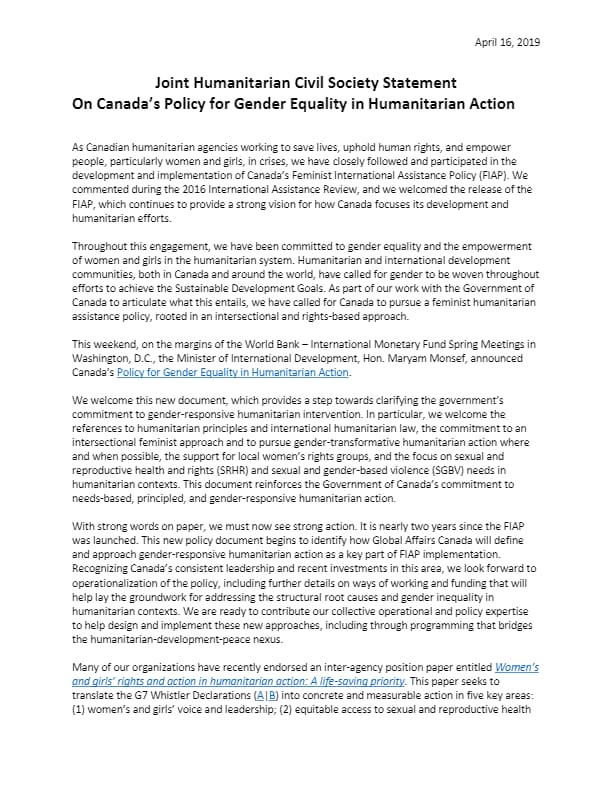As Canadian humanitarian agencies working to save lives, uphold human rights, and empower people, particularly women and girls, in crises, we have closely followed and participated in the development and implementation of Canada’s Feminist International Assistance Policy (FIAP). We commented during the 2016 International Assistance Review, and we welcomed the release of the FIAP, which continues to provide a strong vision for how Canada focuses its development and humanitarian efforts.
Throughout this engagement, we have been committed to gender equality and the empowerment of women and girls in the humanitarian system. Humanitarian and international development communities, both in Canada and around the world, have called for gender to be woven throughout efforts to achieve the Sustainable Development Goals. As part of our work with the Government of Canada to articulate what this entails, we have called for Canada to pursue a feminist humanitarian assistance policy, rooted in an intersectional and rights-based approach.
This weekend, on the margins of the World Bank – International Monetary Fund Spring Meetings in Washington, D.C., the Minister of International Development, Hon. Maryam Monsef, announced Canada’s Policy for Gender Equality in Humanitarian Action.
We welcome this new document, which provides a step towards clarifying the government’s commitment to gender-responsive humanitarian intervention. In particular, we welcome the references to humanitarian principles and international humanitarian law, the commitment to an intersectional feminist approach and to pursue gender-transformative humanitarian action where and when possible, the support for local women’s rights groups, and the focus on sexual and reproductive health and rights (SRHR) and sexual and gender-based violence (SGBV) needs in humanitarian contexts. This document reinforces the Government of Canada’s commitment to needs-based, principled, and gender-responsive humanitarian action.
With strong words on paper, we must now see strong action. It is nearly two years since the FIAP was launched. This new policy document begins to identify how Global Affairs Canada will define and approach gender-responsive humanitarian action as a key part of FIAP implementation.
Recognizing Canada’s consistent leadership and recent investments in this area, we look forward to operationalization of the policy, including further details on ways of working and funding that will help lay the groundwork for addressing the structural root causes and gender inequality in humanitarian contexts. We are ready to contribute our collective operational and policy expertise to help design and implement these new approaches, including through programming that bridges the humanitarian-development-peace nexus.
Many of our organizations have recently endorsed an inter-agency position paper entitled Women’s and girls’ rights and action in humanitarian action: A life-saving priority. This paper seeks to translate the G7 Whistler Declarations (A|B) into concrete and measurable action in five key areas:
(1) women’s and girls’ voice and leadership; (2) equitable access to sexual and reproductive health
services; (3) prevention and response to gender-based violence; (4) preventing sexual harassment, exploitation and abuse; and (5) supporting women’s economic empowerment. These are the kind of specific, measurable actions that will be necessary in the very near term in order to meet the ambition of Canada’s policy agenda.
It is high time that the international community rally together to uphold women’s and girls’ rights where they are furthest behind: in conflict and emergency settings. A more systematic approach for ensuring that humanitarian action responds to women’s and girls’ rights and needs is within reach. Canada, with its Policy for Gender Equality in Humanitarian Action has a crucial leadership role to play. Now, the Government of Canada must take swift and continued action to sustain its constructive role.
We look forward to working with the Government of Canada to ensure meaningful participation of women and girls, hold humanitarian actors accountable for working with women’s and girls’ rights actors, and mobilize long-term predictable funding for these crucial groups. Through these concrete and sustained actions, Canada can continue to help transform the ways humanitarian agencies and the humanitarian coordination system operate on the ground, to better serve the women, men, girls and boys living in crisis and truly leave no one behind.

